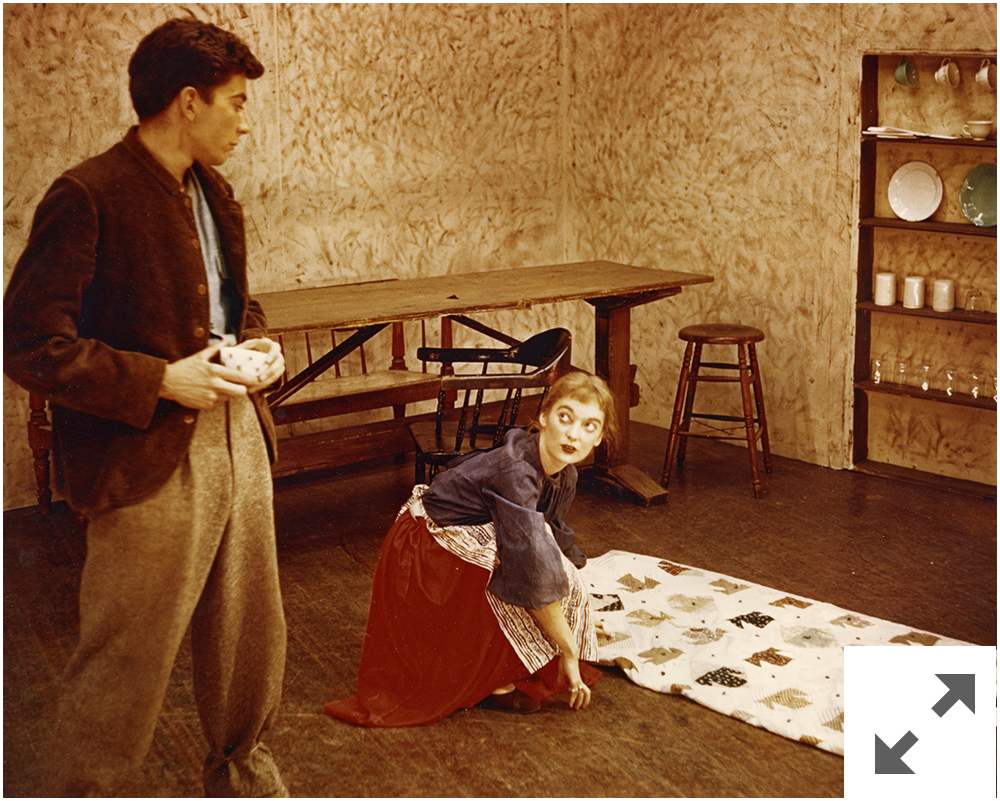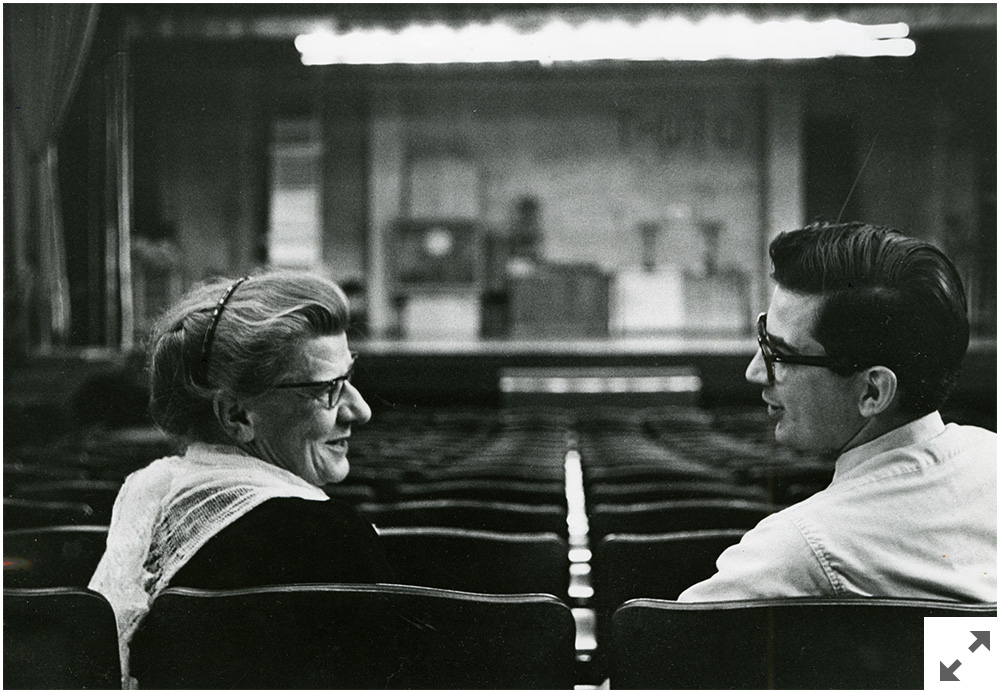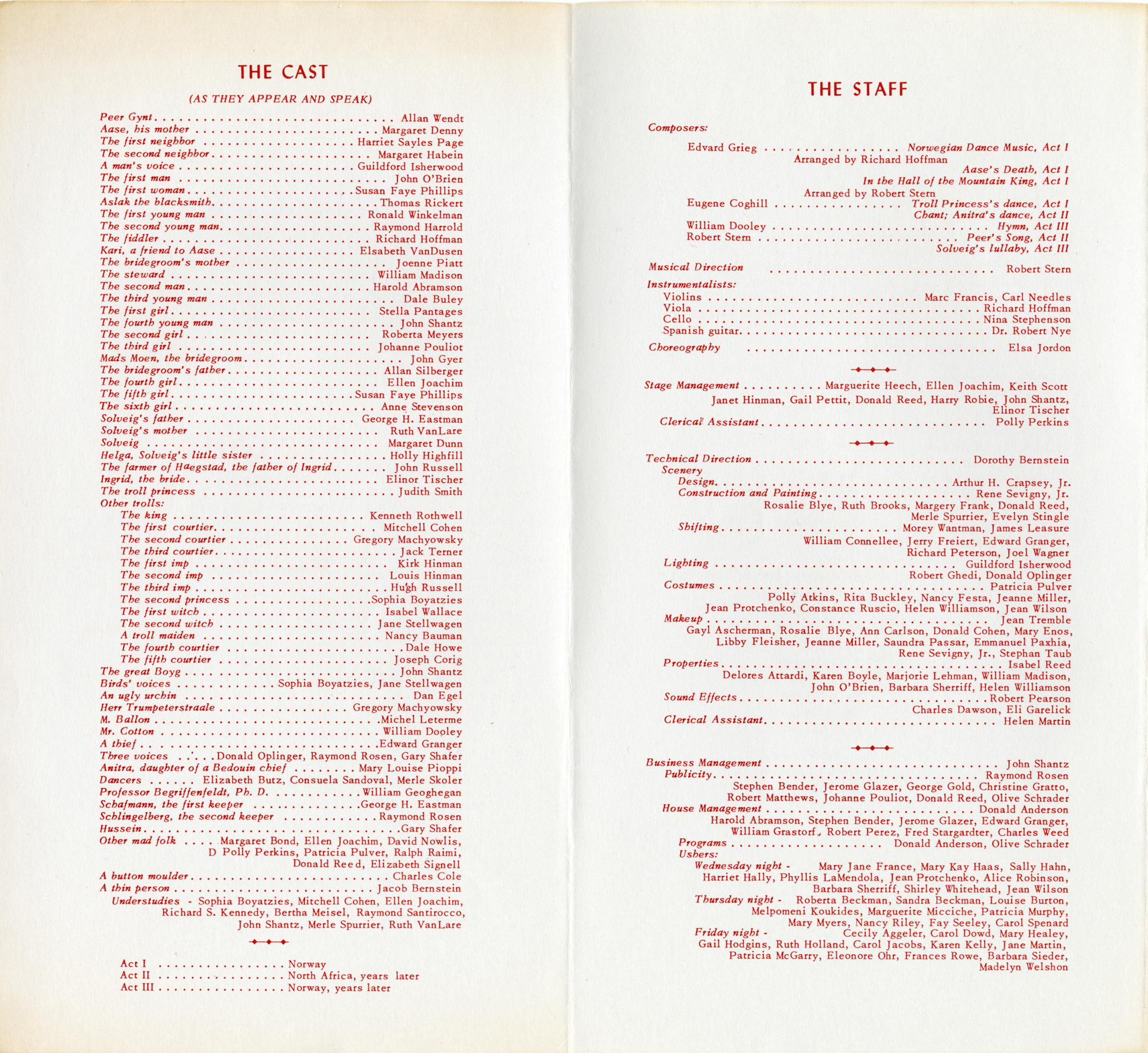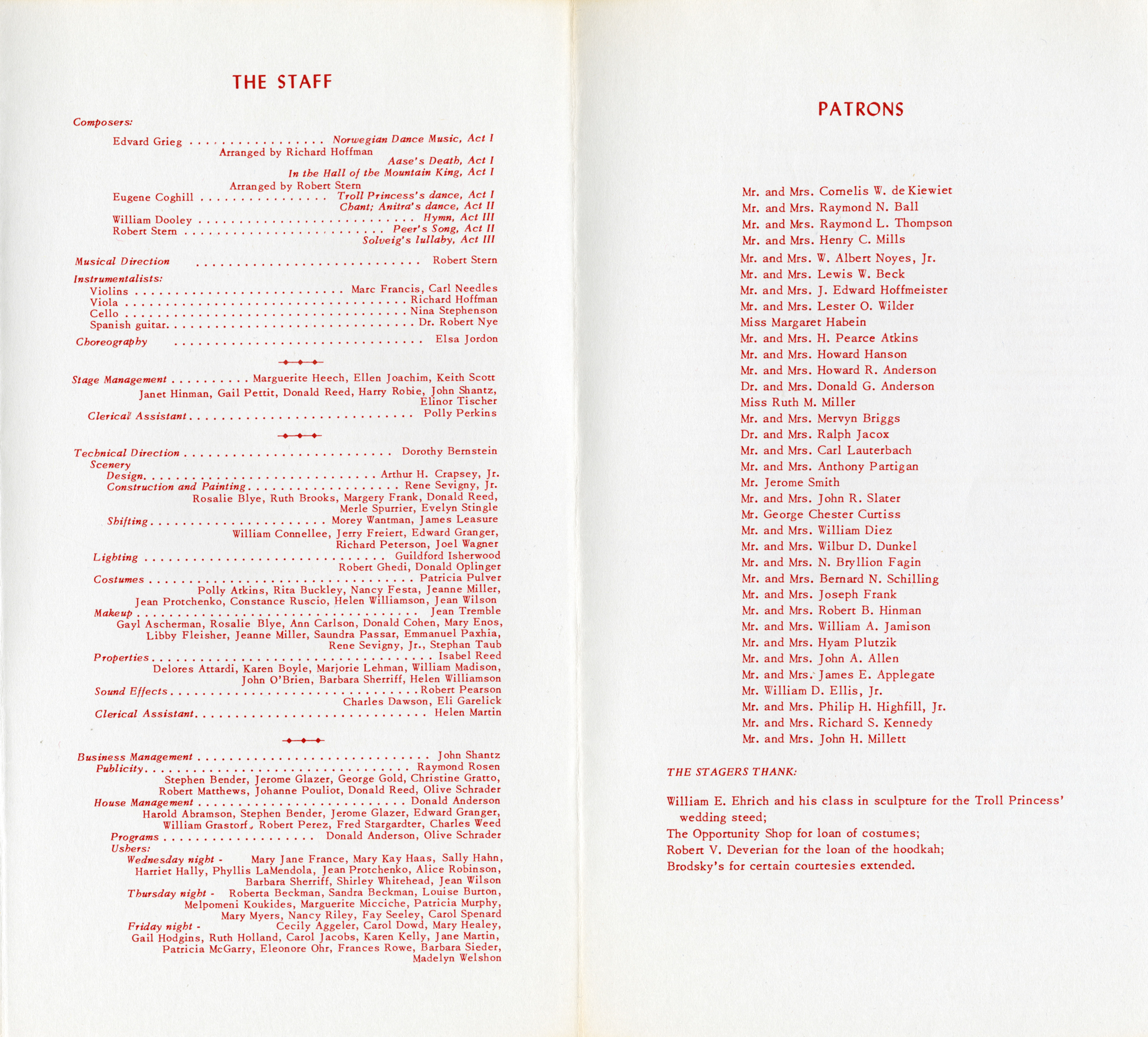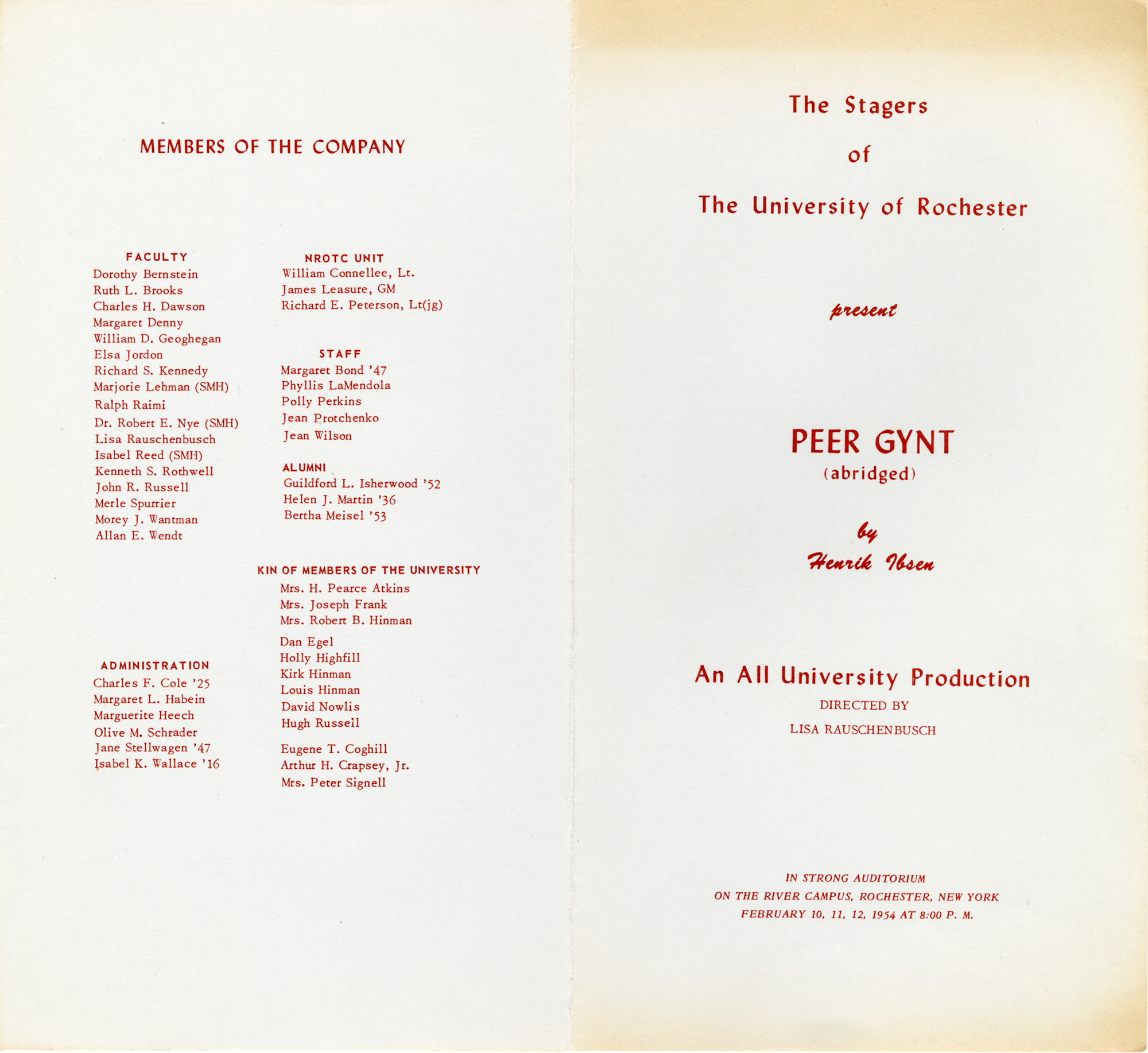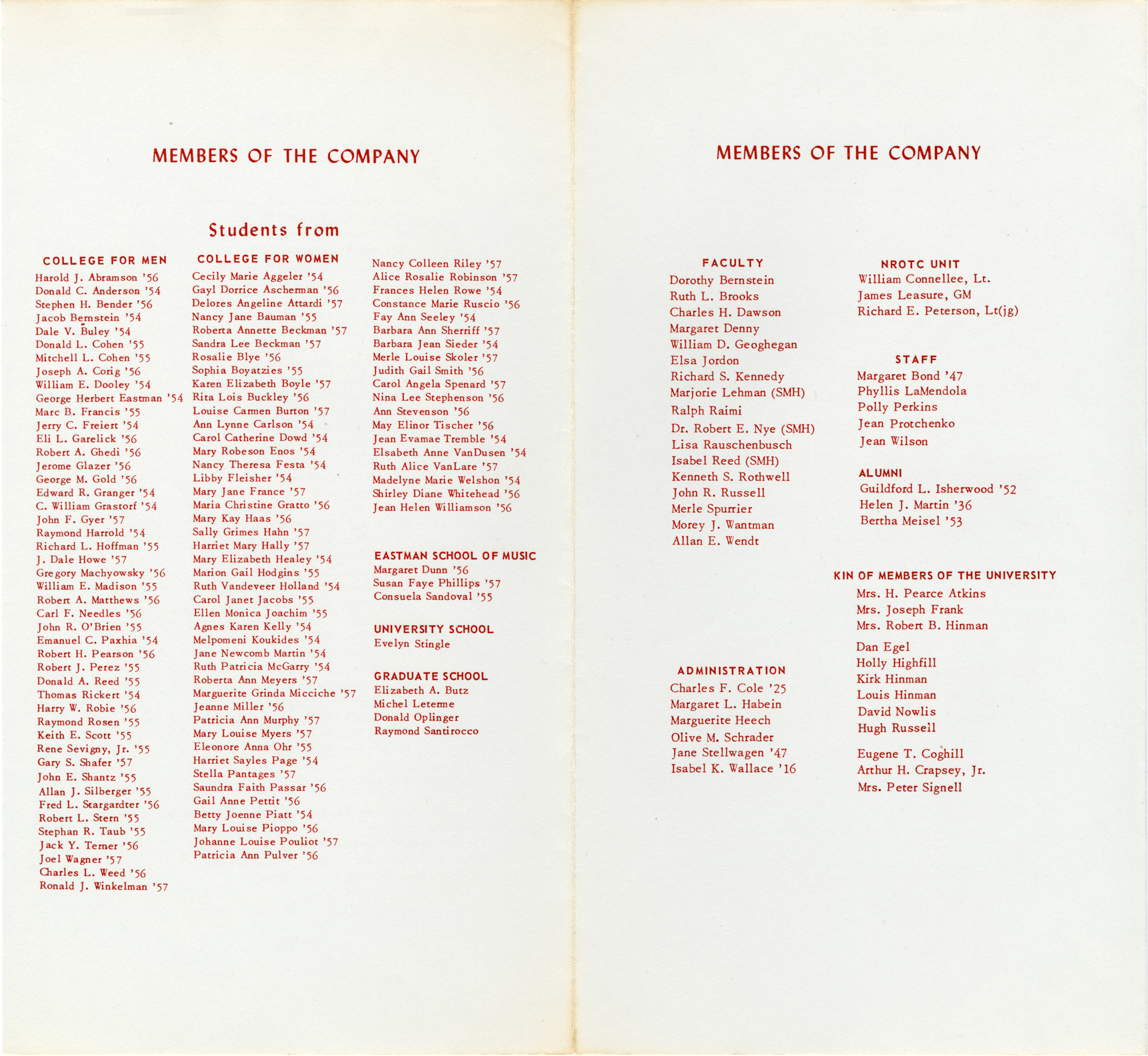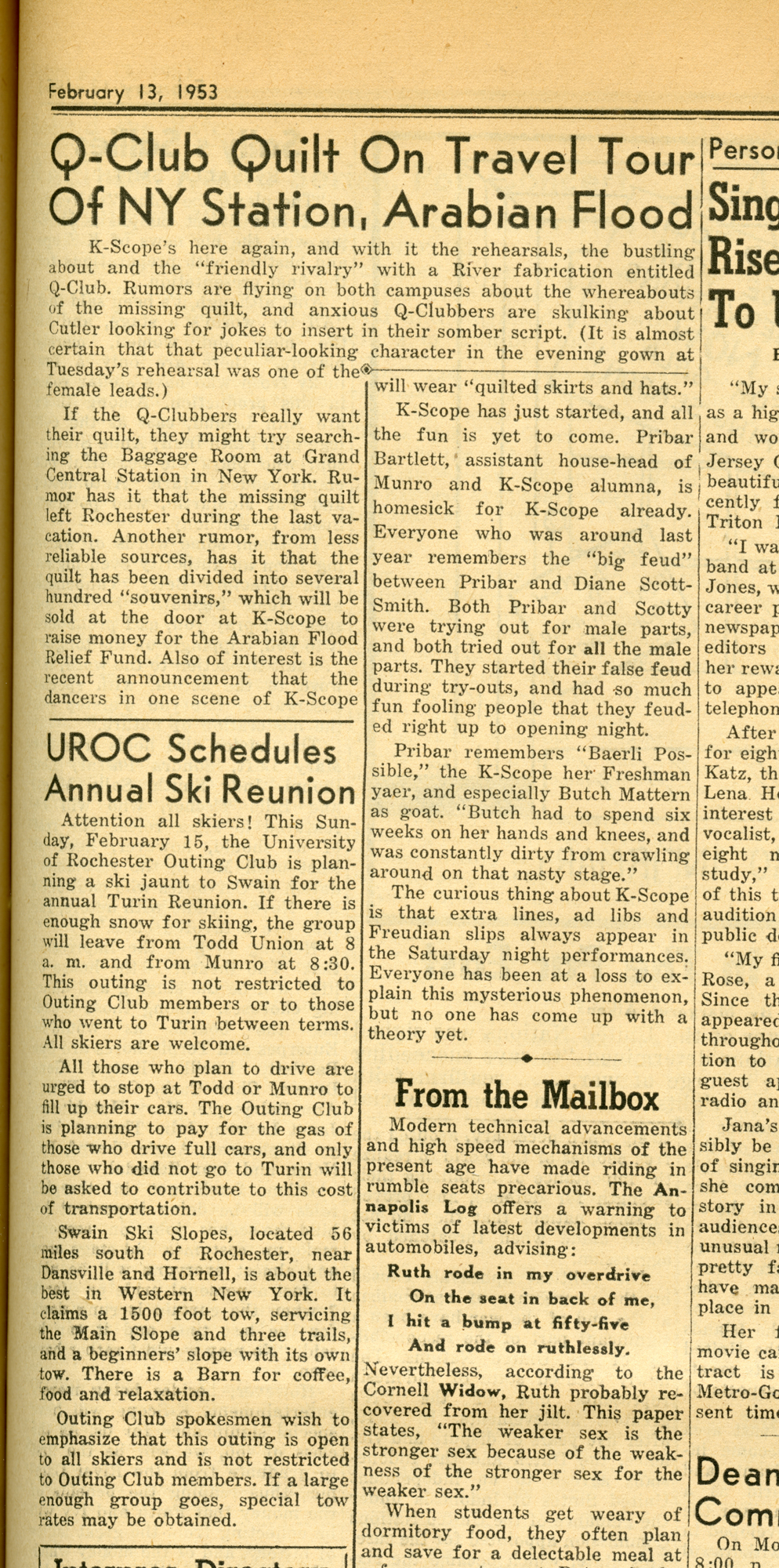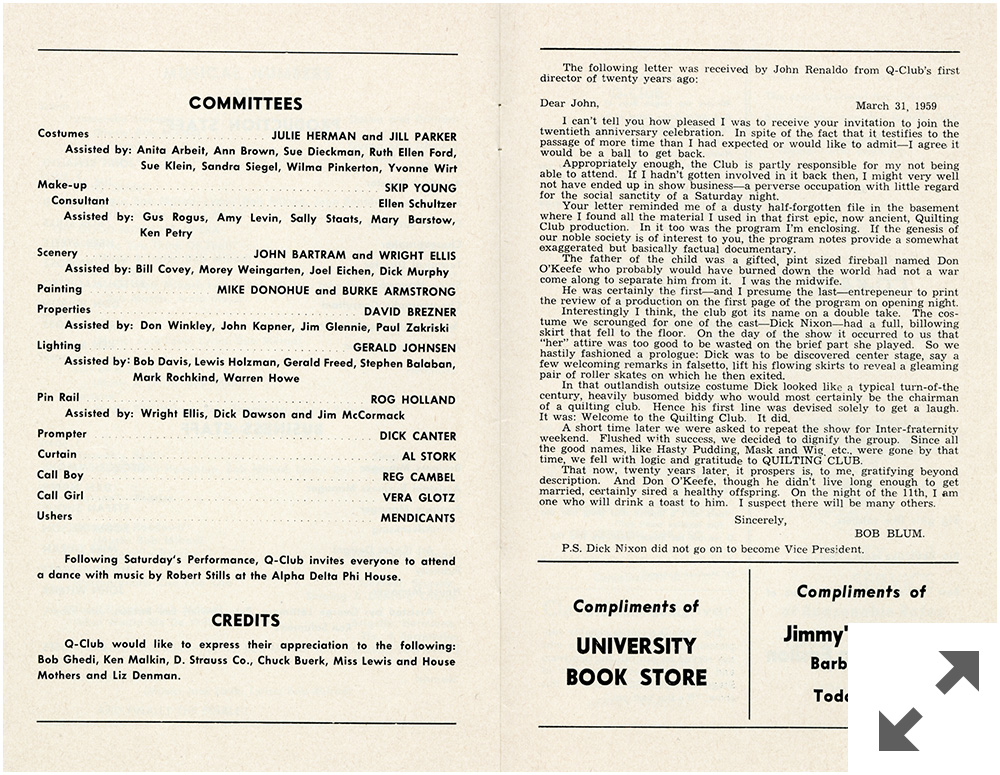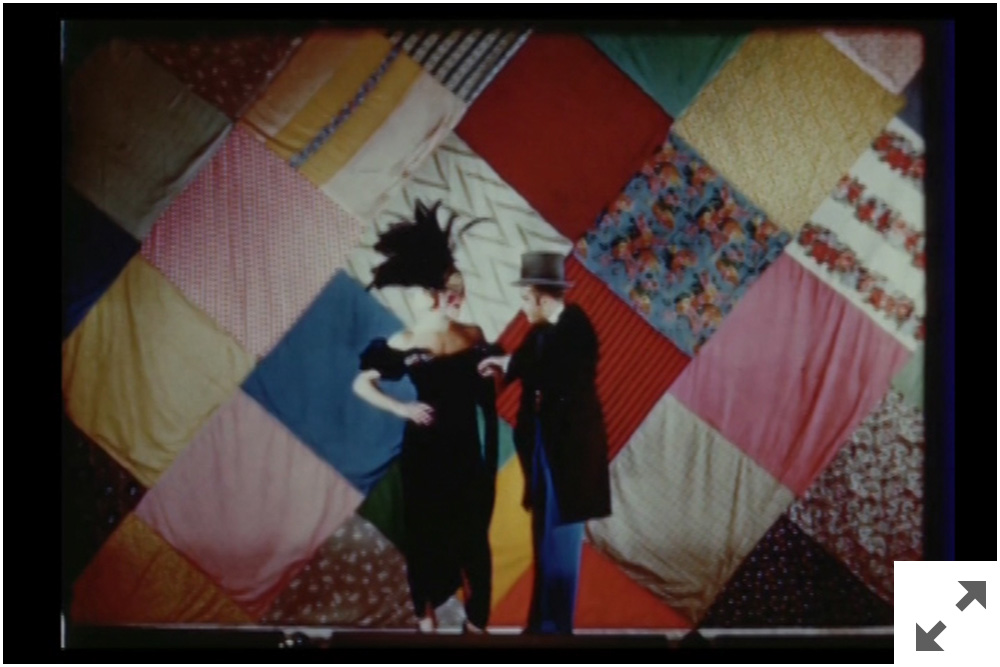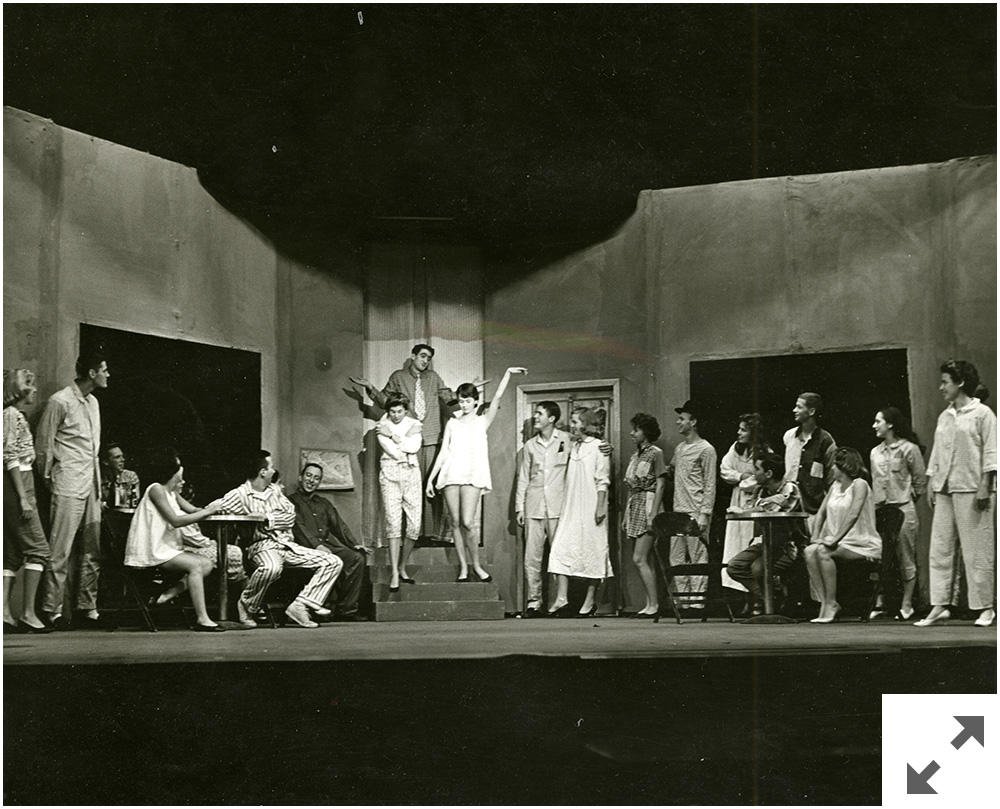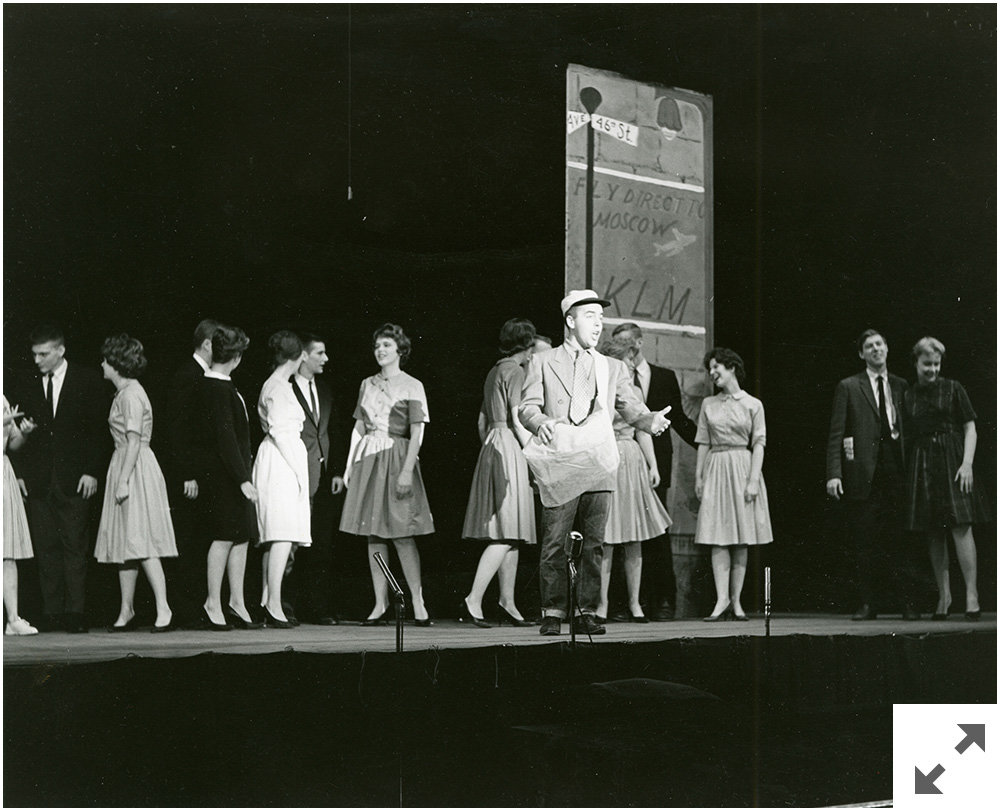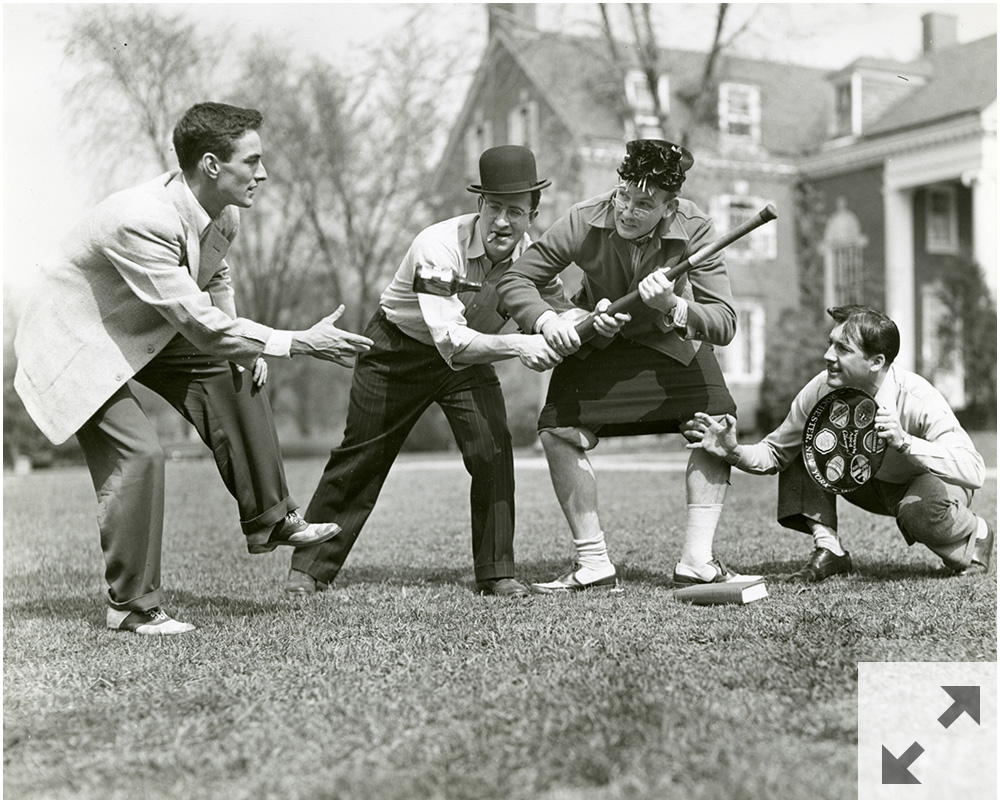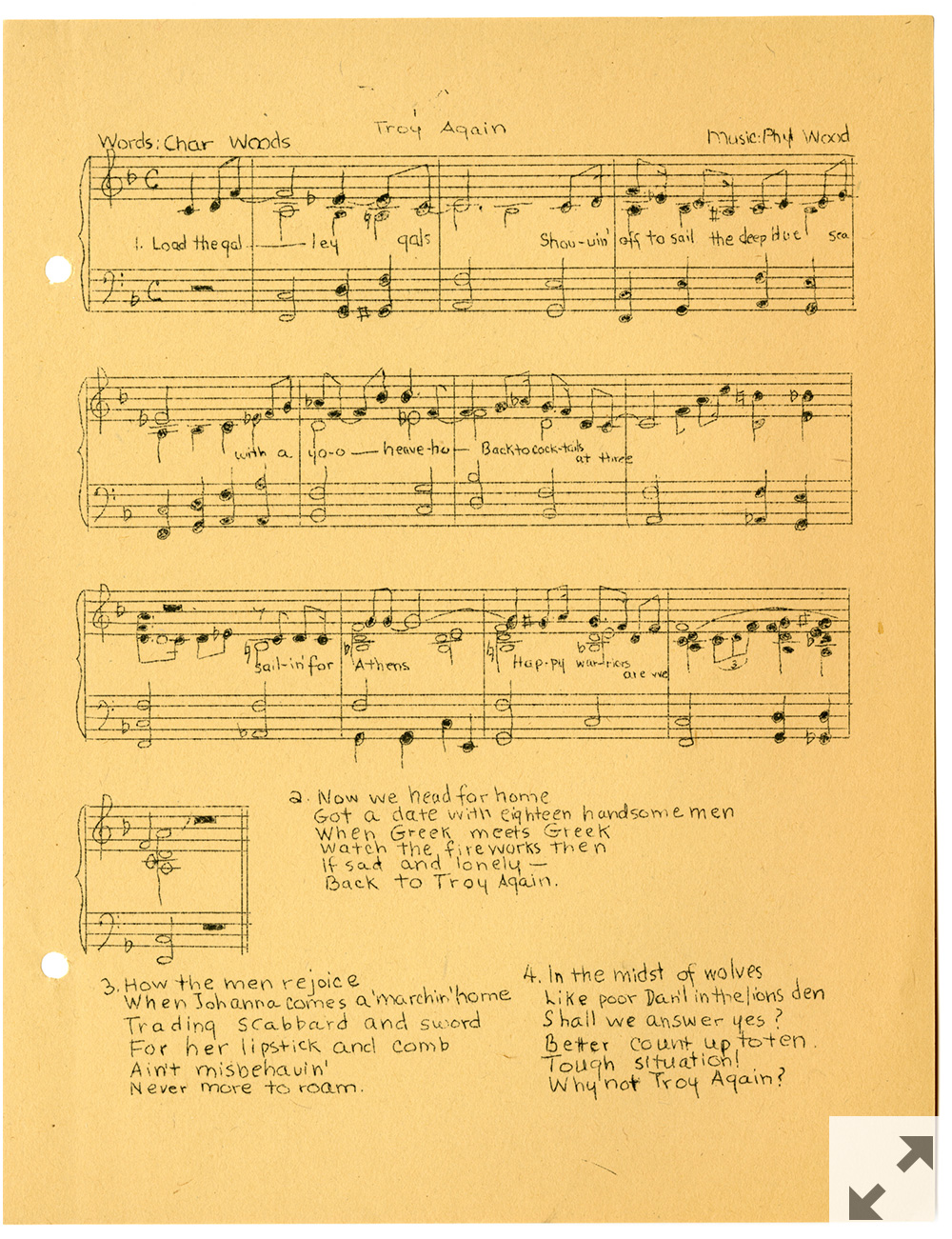The theater group known as “University Players” changed its name to “Stagers” in 1935, and remain active until 1969.
The group was composed of both men from the College for Men on the River Campus and women from the College for Women on the Prince Street Campus during its early years, and it continued to be co-ed when the colleges merged in 1955. The company performed at least one play in the fall and another in the spring. In general, productions were staged in Strong Auditorium, though a few early shows were presented in Cutler Union on the Prince Street Campus.
Stagers usually chose plays from the canon, or standard repertoire, a range which included Aristophanes’s Lysistrata, Shakespeare’s King Lear, and Shaw’s Major Barbara. Occasionally, the group produced less-frequently performed shows and even staged world premieres such as In My Father’s House by Kenneth Cameron (UR 1953), who was a graduate student at the University when he wrote the play. Cameron (pictured here with Louise Barrett in The Playboy of the Western World by John Millington Synge) went on to become a faculty member in the Department of English. He continued to serve UR theater in a number of ways, including as director of three Stagers productions.
Lisa Rauschenbusch with Kenneth Cameron
The success of Stagers cannot be separated from Lisa Rauschenbusch’s legacy at the University. Rauschenbusch was the daughter of the eminent Baptist theologian Walter Rauschenbusch (1861-1918); she was hired as a faculty member in 1946. Remembered for her dedication, Rauschenbusch was a driving force for theater at the University—she directed thirty campus productions from 1946-1969, all the while teaching in the department of English.
Peer Gynt by Henrik Ibsen
February 10, 11, and 12, 1952 - Stagers, Strong Auditorium
Stagers occasionally invited those associated with the University of Rochester—faculty, staff, administration, graduate students, alumni, Eastman students, and even Rochester community members— to audition for parts alongside undergraduate students. “All-University productions,” as they were called, were very popular, and allowed for people to learn from each other outside of the classroom and regular work environment. Notable faculty, staff, and community members who performed in the shows include: Dexter Perkins, professor of history; Wilma Lord Perkins, alumna (UR 1918) and wife of Dexter Perkins; McCrea Hazlett, English professor and
University provost; Sonya Raimi, professional actress and wife of Ralph A. Raimi, professor of mathematics; Merle Spurrier, professor of Physical Education; Bernard A. Weisberger, professor of history; and Thomas Canning, professor at the Eastman School.
Perhaps the most highly praised All-University production was Henrik Ibsen’s Peer Gynt. Upwards of 200 people were involved in staging the play, and Arthur J. May’s A History of the University of Rochester, 1850-1962 states that the performance was considered “a new high in cultural achievement” at the University.
“Q-Club Quilt on Travel Tour of NY Station, Arabian Flood.”
February 13, 1953 - Tower Times
Q-Club and K-Scope members enjoyed a competitive, but friendly, rivalry. Each year, K-Scope members would “steal” the Quilting Club’s quilt, and then the quilt would make an appearance in K-Scope’s production along with entertaining jests aimed at Q-Club members. During the final bows on the last night of K-Scope’s show, the leading actors for the Quilting Club show would present flowers to the K-Scope director; then the Quilters would proceed to make a plug for the Quilting Club musical, always held a few weeks after the Kaleidoscope performance. Additionally, a Quilting Club member would often review Kaleidoscope’s production in the student newspapers, and vice versa.
The Pajama Game by George Abbott
1960 - Co-Kast, Strong Auditorium
Co-Kast’s first production was George and Ira Gershwin’s Girl Crazy in 1958. While this show received tepid reviews in the Campus Times, the group found much success in subsequent years. For example, Co-Kast staged three highly praised musicals originally staged by George Abbott (UR 1911) on Broadway. Damn Yankees was presented in 1959, The Pajama Game in 1960, and Fiorello! in 1965. The group’s last production was A Funny Thing Happened on the Way to the Forum by Burt Shevelove and Larry Gelbart.
The Ten Dollar Bill
1962 - Jesters, Strong Auditorium.
In the 1961-1962 school year, Q-Club and K-Scope merged into the group known as “Jesters.” Not unlike the University as a whole a decade earlier in 1952, the decision to merge was based on the financial pressures that both groups were facing, as well as a drop in the number of students willing to participate.
In the first few years of the Jesters’ activity, the group produced original musical comedies, similar to those that Q-Club and K-Scope had created. Soon though, members of the group would start writing and producing serious drama.
LUGDIS
1947
While extracurricular student theater organizations served increasingly as the central hub of the University theater scene from 1935-1969, senior shows occurred frequently, and faculty and students periodically put on skits and plays independent of any official theater group.
Both Quilting Club and Stagers recognized the importance of this tradition of loosely organized theatrical pursuits and had offshoot divisions that encouraged ad hoc performances. The “Little Upper Gutter Dramatic Intencio Society”—known as LUGDIS and composed of Quilting Club members—put on skits at various social functions such as dances and special dinners.
The Readers’ Theater, coordinated by Stagers, was an informal group that invited the campus to readings of different well-known plays. Often, the group presented a reading at the Welles-Brown Coffee Hour in the spring. The idea behind the Readers’ Theater was to enable people who did not have time to participate in full-scale productions to still participate in theater.
Troy Again
1945 - Kaleidoscope, Cutler Union
Kaleidoscope, nicknamed K-Scope, presented one student-written musical comedy — like Troy Again — each year. The group had its foundation in the annual “Kollege Kaleidoscope” inter-class competition in the early twentieth century. On March 12 and 13, 1937, the first true Kaleidoscope production, entitled A Grim Fairy Tale, was staged. Throughout K-Scope’s history, all cast members, directors, and production staff were female students, and the group remained an integral part of the undergraduate theater scene until 1961. As with the early years of the inter-class competition, the Kaleidoscope shows were sponsored by the YWCA group on campus, and the proceeds supported participation in an annual YWCA conference in Silver Bay, NY.

